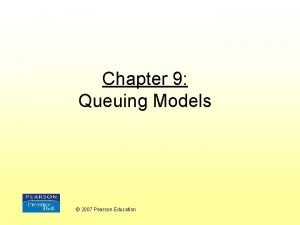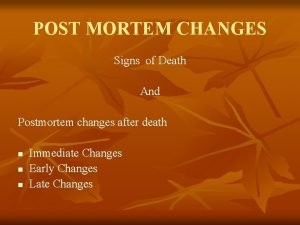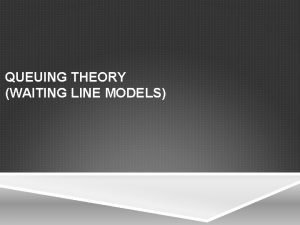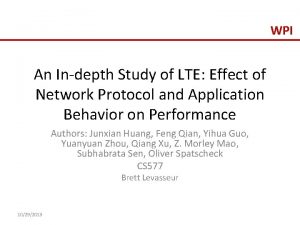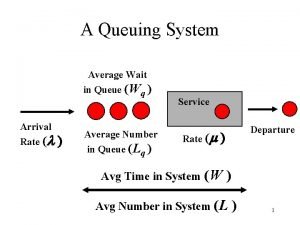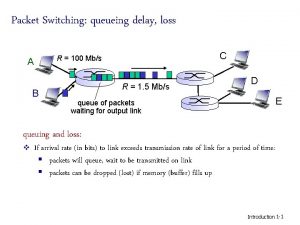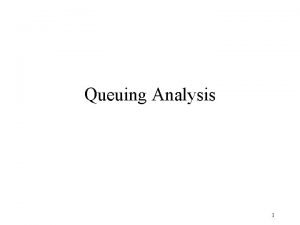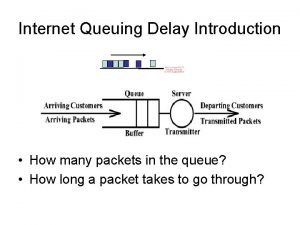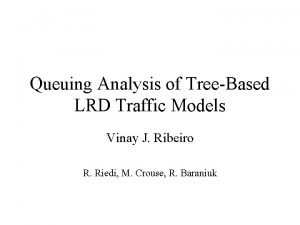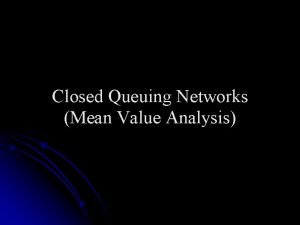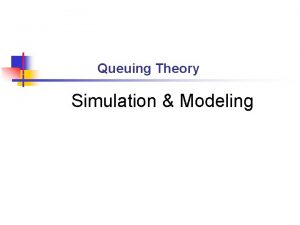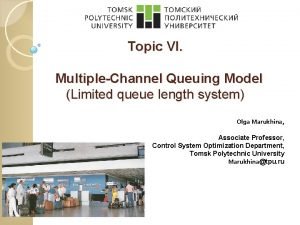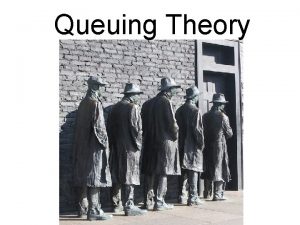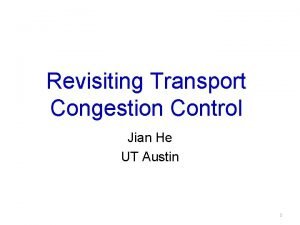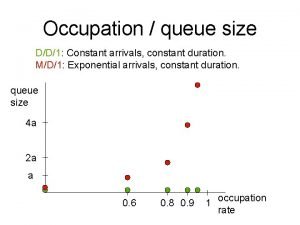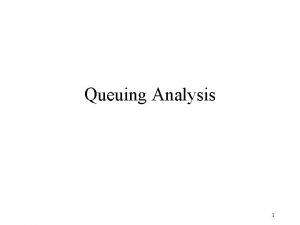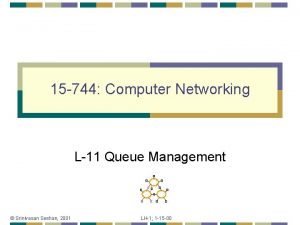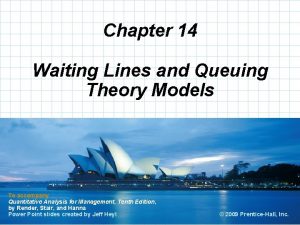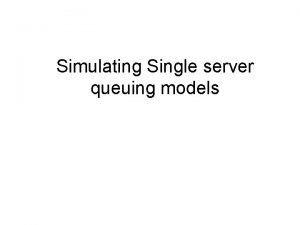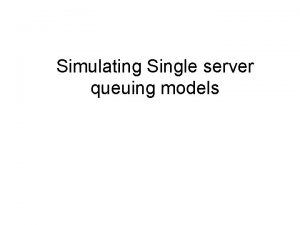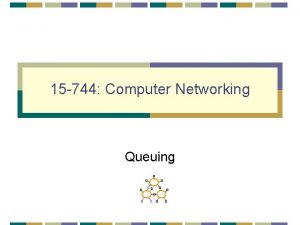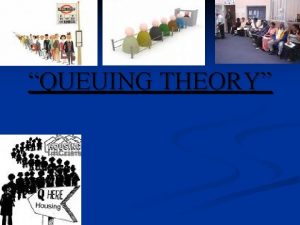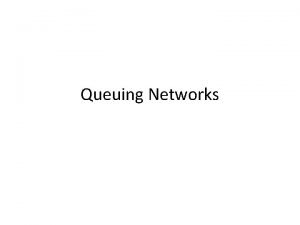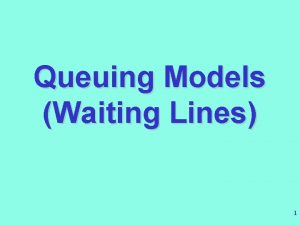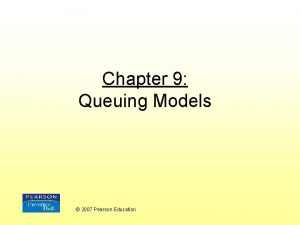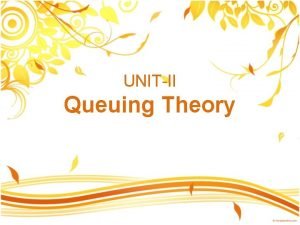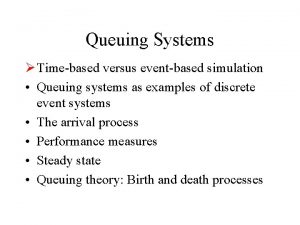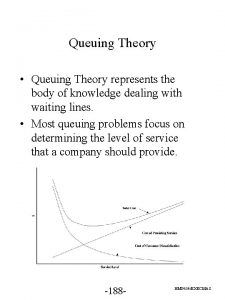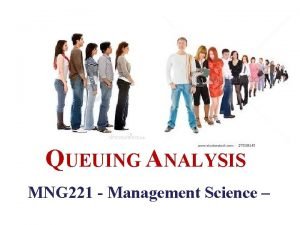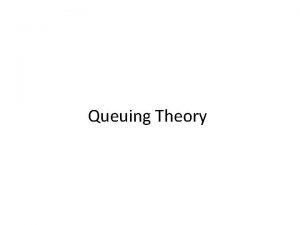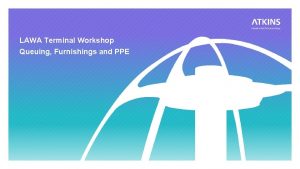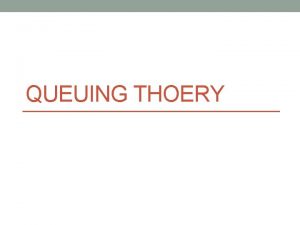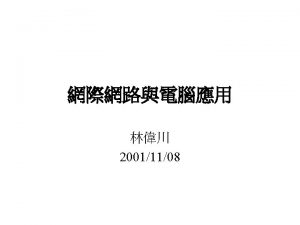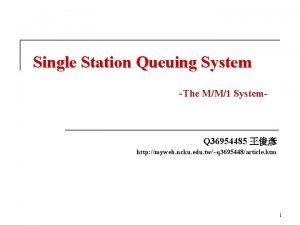Simulating Single server queuing models Simulating Single server























- Slides: 23

Simulating Single server queuing models

Simulating Single server queuing models • Consider the following sequence of activities that each customer undergoes: 1. Customer arrives 2. Customer waits for service if the server is busy. 3. Customer receives service. 4. Customer departs the system.

Analytical Solutions • Analytical solutions for W, L, Wq, Lq exist However, analytical solution exist at infinity which cannot be reached. • Therefore, Simulation is a most.

Flowchart of an arrival event An Arrival Idle Busy Status of Server Customer enters service Customer joins queue More

Flowchart of a Departure event A Departure NO Queue Empty ? Remove customer from Queue and begin service Yes Set system status to idle More

An example of a hand simulation • Consider the following IAT’s and ST’s: • A 1=0. 4, A 2=1. 2, A 3=0. 5, A 4=1. 7, A 5=0. 2, A 6=1. 6, A 7=0. 2, A 8=1. 4, A 9=1. 9, … • S 1=2. 0, S 2=0. 7, S 3=0. 2, S 4=1. 1, S 5=3. 7, S 6=0. 6 • Want: Average delay in queue • Utilization

Initialization Time = 0 System state Server 0 Clock 0 Server status system 0 # in que Times of Arrival A 0. 4 D 999. Eventlist 0 Time 0 0 Of Last Number Total event delayed delay 0 Area Under Q(t) Statistical Counters 0 Area Under B(t)

Arrival Time = 0. 4 System state 0. 4 Clock 0. 4 system 1 Server status 0 # in que Times of Arrival A 1. 6 D 2. 4 Eventlist 0. 4 Time 0 1 Of Last Number Total event delayed delay 0 Area Under Q(t) Statistical Counters 0 Area Under B(t) A 1=0. 4, A 2=1. 2, A 3=0. 5, A 4=1. 7, A 5=0. 2, A 6=1. 6, A 7=0. 2, A 8=1. 4 S 1=2. 0, S 2=0. 7, S 3=0. 2, S 4=1. 1, S 5=3. 7, S 6=0. 6

Arrival Time = 1. 6 System state 1. 6 Clock 0. 4 1 1. 6 system Server status 1 # in que Times of Arrival A 2. 1 D 2. 4 Eventlist 1. 6 Time 0 1 Of Last Number Total event delayed delay 0 Area Under Q(t) Statistical Counters 1. 2 Area Under B(t) A 1=0. 4, A 2=1. 2, A 3=0. 5, A 4=1. 7, A 5=0. 2, A 6=1. 6, A 7=0. 2, A 8=1. 4 S 1=2. 0, S 2=0. 7, S 3=0. 2, S 4=1. 1, S 5=3. 7, S 6=0. 6

Arrival Time = 2. 1 System state 1. 6 2. 1 0. 4 1 1. 6 2. 1 System 2. 1 Clock Server status 2 # in que Times of Arrival A 3. 8 D 2. 4 Eventlist 2. 1 Time 0 1 Of Last Number Total event delayed delay 0. 5 Area Under Q(t) Statistical Counters 1. 7 Area Under B(t) A 1=0. 4, A 2=1. 2, A 3=0. 5, A 4=1. 7, A 5=0. 2, A 6=1. 6, A 7=0. 2, A 8=1. 4 S 1=2. 0, S 2=0. 7, S 3=0. 2, S 4=1. 1, S 5=3. 7, S 6=0. 6

Departure Time = 2. 4 System state 2. 1 2. 4 Clock 1. 6 1 2. 1 System Server status 1 # in que Times of Arrival A 3. 8 D 3. 1 Eventlist 2. 4 Time 2 0. 8 Of Last Number Total event delayed delay 1. 1 Area Under Q(t) Statistical Counters 2. 0 Area Under B(t) A 1=0. 4, A 2=1. 2, A 3=0. 5, A 4=1. 7, A 5=0. 2, A 6=1. 6, A 7=0. 2, A 8=1. 4 S 1=2. 0, S 2=0. 7, S 3=0. 2, S 4=1. 1, S 5=3. 7, S 6=0. 6

Departure Time = 3. 1 System state 3. 1 Clock 2. 1 1 Server status System 0 # in que Times of Arrival A 3. 8 D 3. 3 Eventlist 3. 1 Time 3 1. 8 Of Last Number Total event delayed delay 1. 8 Area Under Q(t) Statistical Counters 2. 7 Area Under B(t) A 1=0. 4, A 2=1. 2, A 3=0. 5, A 4=1. 7, A 5=0. 2, A 6=1. 6, A 7=0. 2, A 8=1. 4 S 1=2. 0, S 2=0. 7, S 3=0. 2, S 4=1. 1, S 5=3. 7, S 6=0. 6

Departure Time = 3. 1 System state 3. 3 Clock 0 Server status System 0 # in que Times of Arrival A 3. 8 D 999. Eventlist 3. 3 Time 3 1. 8 Of Last Number Total event delayed delay 1. 8 Area Under Q(t) Statistical Counters 2. 9 Area Under B(t) A 1=0. 4, A 2=1. 2, A 3=0. 5, A 4=1. 7, A 5=0. 2, A 6=1. 6, A 7=0. 2, A 8=1. 4 S 1=2. 0, S 2=0. 7, S 3=0. 2, S 4=1. 1, S 5=3. 7, S 6=0. 6

Departure Time = 3. 1 System state 3. 8 Clock 3. 8 1 Server status System 0 # in que Times of Arrival A 4. 0 D 4. 9 Eventlist 3. 8 Time 4 1. 8 Of Last Number Total event delayed delay 1. 8 Area Under Q(t) Statistical Counters 2. 9 Area Under B(t) A 1=0. 4, A 2=1. 2, A 3=0. 5, A 4=1. 7, A 5=0. 2, A 6=1. 6, A 7=0. 2, A 8=1. 4 S 1=2. 0, S 2=0. 7, S 3=0. 2, S 4=1. 1, S 5=3. 7, S 6=0. 6

Departure Time = 3. 1 System state 4. 0 3. 8 4. 0 System 1 Server status 1 # in que Times of Arrival 4. 0 Clock A 5. 6 D 4. 9 Eventlist 4. 0 Time 4 1. 8 Of Last Number Total event delayed delay 1. 8 Area Under Q(t) Statistical Counters 3. 1 Area Under B(t) A 1=0. 4, A 2=1. 2, A 3=0. 5, A 4=1. 7, A 5=0. 2, A 6=1. 6, A 7=0. 2, A 8=1. 4 S 1=2. 0, S 2=0. 7, S 3=0. 2, S 4=1. 1, S 5=3. 7, S 6=0. 6

Departure Time = 3. 1 System state 4. 9 Clock 4. 0 1 Server status System 0 # in que Times of Arrival A 5. 6 D 8. 6 Eventlist 4. 9 Time 5 2. 7 Of Last Number Total event delayed delay 2. 7 4. 0 Area Under Q(t) B(t) Statistical Counters A 1=0. 4, A 2=1. 2, A 3=0. 5, A 4=1. 7, A 5=0. 2, A 6=1. 6, A 7=0. 2, A 8=1. 4 S 1=2. 0, S 2=0. 7, S 3=0. 2, S 4=1. 1, S 5=3. 7, S 6=0. 6

Monte Carlo Simulation • Solving deterministic problems using stochastic models. – Example: estimate • It is efficient in solving multi dimensional integrals.

Monte Carlo Simulation • To illustrate, consider a known region R with area A and R 1 subset of R whose area A 1 in unknown. • To estimate the area of R 1 we can through random points in the region R. The ratio of points in the region R 1 over the points in R approximately equals the ratio of A 1/A. R R 1

Monte Carlo Simulation • To estimate the integral I. one can estimate the area under the curve of g. – Suppose that M = max {g(x) } on [a, b] 1. Select random numbers X 1, X 2, …, Xn in [a, b] M R And Y 1, Y 2, … , Yn in [0, M] R 1 a 2. Count how many points (Xi, Yi) in R 1, say C 1 b 3. The estimate of I is then C 1 M(b-a)/n

Advantages of Simulation • Most complex, real-world systems with stochastic elements that cannot be described by mathematical models. Simulation is often the only investigation possible • Simulation allow us to estimate the performance of an existing system under proposed operating conditions. • Alternative proposed system designs can be compared with the existing system • We can maintain much better control over the experiments than with the system itself • Study the system with a long time frame

Disadvantages of Simulation • Simulation produces only estimates of performance under a particular set of parameters • Expensive and time consuming to develop • The Large volume of numbers and the impact of the realistic animation often create high level of confidence than is justified.

Pitfalls of Simulation • Failure to have a well defined set of objectives at the beginning of the study • Inappropriate level of model details • Failure to communicate with manager during the course of simulation • Treating a simulation study as if it is a complicated exercise in computer programming • Failure to have well trained people familiar with operations research and statistical analysis • Using commercial software that may contain errors

Pitfalls of Simulation cont. • Reliance on simulator that make simulation accessible to anyone • Misuse of animation • Failure to account correctly for sources of randomness in the actual system • Using arbitrary probability distributions as input of the simulation • Do output analysis un correctly • Making a single replication and treating the output as true answers • Comparing alternative designs based on one replication of each design • Using wrong measure of performance
 Kendall's notation
Kendall's notation Conditions simulating rigor mortis
Conditions simulating rigor mortis Diaphanous test
Diaphanous test Queuing theory and waiting line model
Queuing theory and waiting line model Queuing delay
Queuing delay Queuing process
Queuing process Four sources of packet delay
Four sources of packet delay Queuing analysis examples
Queuing analysis examples Queuing delay
Queuing delay Queuing theory formula
Queuing theory formula Advanced queing
Advanced queing Cucm native call queuing
Cucm native call queuing Closed queuing network
Closed queuing network Queuing theory simulation
Queuing theory simulation Multi channel queuing model
Multi channel queuing model Queuing theory calculator
Queuing theory calculator Rtt
Rtt Dd1 queuing
Dd1 queuing Mmsmms
Mmsmms Queuing theory formula
Queuing theory formula Fair queuing
Fair queuing Srinivasan seshan
Srinivasan seshan Waiting cost queuing theory
Waiting cost queuing theory Round robin scheduling example
Round robin scheduling example
